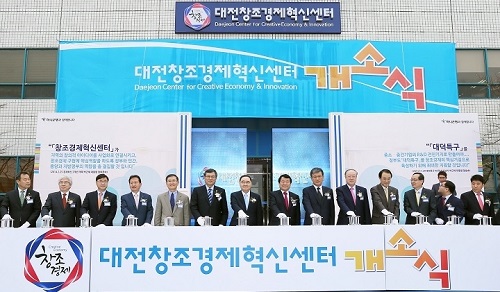

On March 26, the opening ceremony of Center for Creative Economy & Innovation (CCEI) was held in KAIST Main Campus. Located on the first floor of the Educational Support Building (W8), it is the first center of its kind to be opened in Korea, and a total of 17 centers will be opened by the first half of 2015.

As per President Geun-hye Park’s policy on creative economy, the Ministry of Science, ICT & Future Planning (MSIP) opened the first CCEI in Daejeon. MSIP hopes that CCEI will act as a base for developing regionally strategic industries and creating a favorable ecosystem for startup companies. While it is currently operated under KAIST, MSIP plans to eventually separate CCEI as an independent organization.
Professor Lak-Kyoung Song of KAIST Graduate School of Innovation and Technology Management will head CCEI. MSIP said that Professor Song is best suited for creating an ecosystem for venture companies and managing support for companies due to his past experience in serving as the chief executive officer of Korea Technology Banking (KTB) Incubating and other key positions in the related field.
CCEI will carry out many different roles in the spreading of creative economy to innovate the regional economy. First, regarding the Five Strategic Industries (integration of wireless communication, automation of robots, medical and biotechnology, processing of metals, intellectual property services), CCEI will cooperate with Daejeon Technopark and Daejeon Development Institute to help the regional industries develop and reduce excessive regulations by the end of May. Second, CCEI will hold educational programs on entrepreneurship for researchers, undergraduate and graduate students, and industrial workers. In addition, CCEI will raise Regional Startup Accelerators (RSAs), which will select and invest in prospective entrepreneurs. CCEI will help regional venture capitals, angel clubs (investors), and technology holdings to grow into RSAs. CCEI will also build and operate the Six-Month Challenge Platform, which will minimize the time and cost for commercializing ideas. Prospective ideas from the Creative Economy Town and CCEI will be further developed (by consulting and producing prototypes) and made ready for investments and sales in foreign markets. Finally, CCEI will provide space for entrepreneurs and investors so that they can communicate and collaborate on various ideas.
Located on the third floor of the same building is Startup KAIST. Startup KAIST and CCEI have similar objectives and are open to students, so students can choose the one that provides more benefits.

